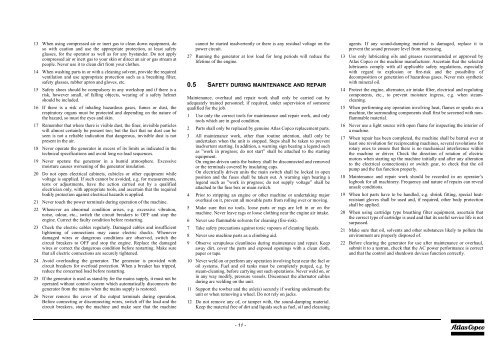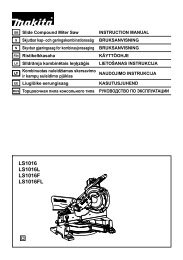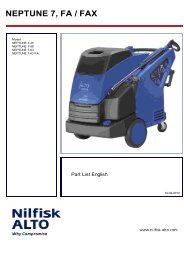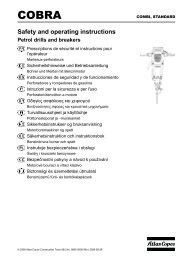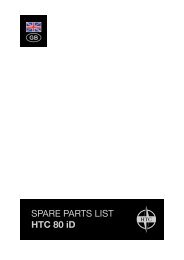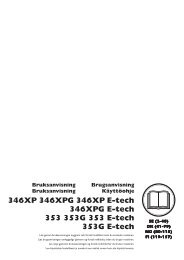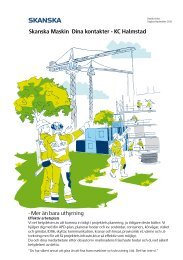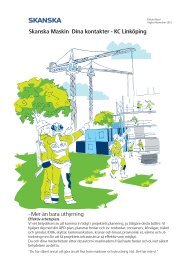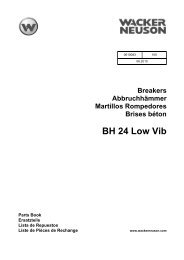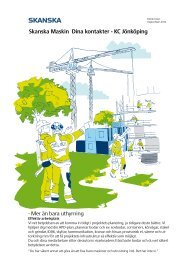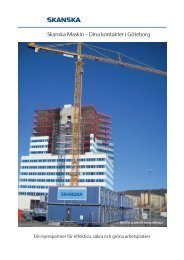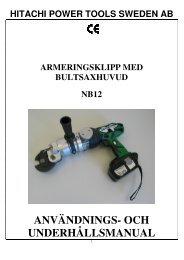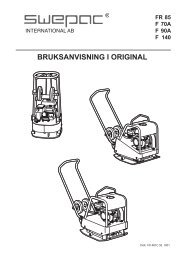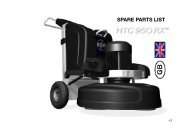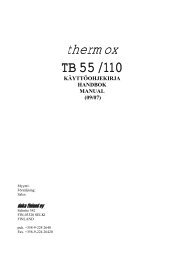QAX 40.book
QAX 40.book
QAX 40.book
You also want an ePaper? Increase the reach of your titles
YUMPU automatically turns print PDFs into web optimized ePapers that Google loves.
13 When using compressed air or inert gas to clean down equipment, do<br />
so with caution and use the appropriate protection, at least safety<br />
glasses, for the operator as well as for any bystander. Do not apply<br />
compressed air or inert gas to your skin or direct an air or gas stream at<br />
people. Never use it to clean dirt from your clothes.<br />
14 When washing parts in or with a cleaning solvent, provide the required<br />
ventilation and use appropriate protection such as a breathing filter,<br />
safety glasses, rubber apron and gloves, etc.<br />
15 Safety shoes should be compulsory in any workshop and if there is a<br />
risk, however small, of falling objects, wearing of a safety helmet<br />
should be included.<br />
16 If there is a risk of inhaling hazardous gases, fumes or dust, the<br />
respiratory organs must be protected and depending on the nature of<br />
the hazard, so must the eyes and skin.<br />
17 Remember that where there is visible dust, the finer, invisible particles<br />
will almost certainly be present too; but the fact that no dust can be<br />
seen is not a reliable indication that dangerous, invisible dust is not<br />
present in the air.<br />
18 Never operate the generator in excess of its limits as indicated in the<br />
technical specifications and avoid long no-load sequences.<br />
19 Never operate the generator in a humid atmosphere. Excessive<br />
moisture causes worsening of the generator insulation.<br />
20 Do not open electrical cabinets, cubicles or other equipment while<br />
voltage is supplied. If such cannot be avoided, e.g. for measurements,<br />
tests or adjustments, have the action carried out by a qualified<br />
electrician only, with appropriate tools, and ascertain that the required<br />
bodily protection against electrical hazards is applied.<br />
21 Never touch the power terminals during operation of the machine.<br />
22 Whenever an abnormal condition arises, e.g. excessive vibration,<br />
noise, odour, etc., switch the circuit breakers to OFF and stop the<br />
engine. Currect the faulty condition before restarting.<br />
23 Check the electric cables regularly. Damaged cables and insufficient<br />
lightening of connections may cause electric shocks. Whenever<br />
damaged wires or dangerous conditions are observed, switch the<br />
circuit breakers to OFF and stop the engine. Replace the damaged<br />
wires or correct the dangerous condition before restarting. Make sure<br />
that all electric connections are securely tightened.<br />
24 Avoid overloading the generator. The generator is provided with<br />
circuit breakers for overload protection. When a breaker has tripped,<br />
reduce the concerned load before restarting.<br />
25 If the generator is used as stand-by for the mains supply, it must not be<br />
operated without control system which automatically disconnects the<br />
generator from the mains when the mains supply is restored.<br />
26 Never remove the cover of the output terminals during operation.<br />
Before connecting or disconnecting wires, switch off the load and the<br />
circuit breakers, stop the machine and make sure that the machine<br />
cannot be started inadvertently or there is any residual voltage on the<br />
power circuit.<br />
27 Running the generator at low load for long periods will reduce the<br />
lifetime of the engine.<br />
0.5 SAFETY DURING MAINTENANCE AND REPAIR<br />
Maintenance, overhaul and repair work shall only be carried out by<br />
adequately trained personnel; if required, under supervision of someone<br />
qualified for the job.<br />
1 Use only the correct tools for maintenance and repair work, and only<br />
tools which are in good condition.<br />
2 Parts shall only be replaced by genuine Atlas Copco replacement parts.<br />
3 All maintenance work, other than routine attention, shall only be<br />
undertaken when the unit is stopped. Steps shall be taken to prevent<br />
inadvertent starting. In addition, a warning sign bearing a legend such<br />
as ”work in progress; do not start” shall be attached to the starting<br />
equipment.<br />
On engine-driven units the battery shall be disconnected and removed<br />
or the terminals covered by insulating caps.<br />
On electrically driven units the main switch shall be locked in open<br />
position and the fuses shall be taken out. A warning sign bearing a<br />
legend such as ”work in progress; do not supply voltage” shall be<br />
attached to the fuse box or main switch.<br />
4 Prior to stripping an engine or other machine or undertaking major<br />
overhaul on it, prevent all movable parts from rolling over or moving.<br />
5 Make sure that no tools, loose parts or rags are left in or on the<br />
machine. Never leave rags or loose clothing near the engine air intake.<br />
6 Never use flammable solvents for cleaning (fire-risk).<br />
7 Take safety precautions against toxic vapours of cleaning liquids.<br />
8 Never use machine parts as a climbing aid.<br />
9 Observe scrupulous cleanliness during maintenance and repair. Keep<br />
away dirt, cover the parts and exposed openings with a clean cloth,<br />
paper or tape.<br />
10 Never weld on or perform any operation involving heat near the fuel or<br />
oil systems. Fuel and oil tanks must be completely purged, e.g. by<br />
steam-cleaning, before carrying out such operations. Never weld on, or<br />
in any way modify, pressure vessels. Disconnect the alternator cables<br />
during arc welding on the unit.<br />
11 Support the towbar and the axle(s) securely if working underneath the<br />
unit or when removing a wheel. Do not rely on jacks.<br />
12 Do not remove any of, or tamper with, the sound-damping material.<br />
Keep the material free of dirt and liquids such as fuel, oil and cleansing<br />
agents. If any sound-damping material is damaged, replace it to<br />
prevent the sound pressure level from increasing.<br />
13 Use only lubricating oils and greases recommended or approved by<br />
Atlas Copco or the machine manufacturer. Ascertain that the selected<br />
lubricants comply with all applicable safety regulations, especially<br />
with regard to explosion or fire-risk and the possibility of<br />
decomposition or generation of hazardous gases. Never mix synthetic<br />
with mineral oil.<br />
14 Protect the engine, alternator, air intake filter, electrical and regulating<br />
components, etc., to prevent moisture ingress, e.g. when steamcleaning.<br />
15 When performing any operation involving heat, flames or sparks on a<br />
machine, the surrounding components shall first be screened with nonflammable<br />
material.<br />
16 Never use a light source with open flame for inspecting the interior of<br />
a machine.<br />
17 When repair has been completed, the machine shall be barred over at<br />
least one revolution for reciprocating machines, several revolutions for<br />
rotary ones to ensure that there is no mechanical interference within<br />
the machine or driver. Check the direction of rotation of electric<br />
motors when starting up the machine initially and after any alteration<br />
to the electrical connection(s) or switch gear, to check that the oil<br />
pump and the fan function properly.<br />
18 Maintenance and repair work should be recorded in an operator’s<br />
logbook for all machinery. Frequency and nature of repairs can reveal<br />
unsafe conditions.<br />
19 When hot parts have to be handled, e.g. shrink fitting, special heatresistant<br />
gloves shall be used and, if required, other body protection<br />
shall be applied.<br />
20 When using cartridge type breathing filter equipment, ascertain that<br />
the correct type of cartridge is used and that its useful service life is not<br />
surpassed.<br />
21 Make sure that oil, solvents and other substances likely to pollute the<br />
environment are properly disposed of.<br />
22 Before clearing the generator for use after maintenance or overhaul,<br />
submit it to a testrun, check that the AC power performance is correct<br />
and that the control and shutdown devices function correctly.<br />
- 11 -


